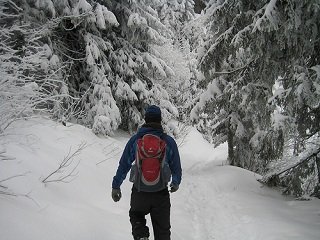 For some outdoorsmen, winter can be a long season. Many just can’t enjoy the thing they love when the snow falls and temperatures drop. However, if you find yourself looking at the outdoors through a window this winter, that just means you’re not trying hard enough. For example, while I love hiking and trail running during the warmer months, I’ve found one of my favorite activities to be hiking during the winter. There’s nothing like the peaceful tranquility and stark contrast of white snow and bare trees that accompany a winter hike. If you’ve never hiked during the winter before, however, there are a few things you should know before doing so and below, you’ll find several tips to help make your first winter hike as enjoyable as it can be.
For some outdoorsmen, winter can be a long season. Many just can’t enjoy the thing they love when the snow falls and temperatures drop. However, if you find yourself looking at the outdoors through a window this winter, that just means you’re not trying hard enough. For example, while I love hiking and trail running during the warmer months, I’ve found one of my favorite activities to be hiking during the winter. There’s nothing like the peaceful tranquility and stark contrast of white snow and bare trees that accompany a winter hike. If you’ve never hiked during the winter before, however, there are a few things you should know before doing so and below, you’ll find several tips to help make your first winter hike as enjoyable as it can be.
Since you’ll be on your feet the whole time you’re on the trail, it’s best to start from the ground up, as far as protection from the snow goes, and quality footwear designed to withstand the cold, as well as water, is important. Low profile boots and shoes are good for warmer months, but I’d suggest investing in a pair of warm, waterproof mid-length boots for winter hikes. The longer length will protect you from snow and water, should you find yourself ankle deep in either one. Also, the waterproof shell will keep your boots from collecting water and freezing, which will feel like you’re dragging two blocks of ice and makes hiking much more difficult. Mid-length boots from Keen, Merrell, or The North Face are great choices for footwear in these situations.
Other great investments for frequent winter hikers include gaiters and snow shoes, both of which go a long way towards protecting their user from the elements. Gaiters are sleeves of durable, waterproof material—usually nylon—spanning from your knees to your feet and fasten around the sole of your boots. They keep your lower legs from getting soaked by brush and snow. REI, Mountain Hardwear, and Outdoor Research all offer great gaiters for a variety of situations. If you’re headed into fresh or deeper snow, then it also might be a good idea to pick up, or rent, a pair of snow shoes. Snow shoes distribute your body weight on a wider scale, which lessens the pressure between your feet and the snow and prevents you from sinking too deeply while hiking. Check into products from Atlas, MSR, or Tubbs if you think you’ll need a pair of snow shoes.
Other products that would be beneficial to winter hikers include trekking poles, balaclavas, and hand and feet warmers. Also, it can be difficult to grip zippers with gloves on, so attaching loops to your zippers is a good idea. Furthermore, if you plan to try and bring warm liquids for the hike, it’s best to take an insulated Thermos, or a Hydroflask water bottle. Lastly, be sure to pack any important or commonly used gear at the most accessible parts of your pack. This will make rest periods quick and prevent your body from cooling down during a long break.
Winter hiking is a great way to get out of the house and avoid cabin fever during colder months of the year. There’s tranquility in the forests during winter that isn’t present during other seasons and any outdoors enthusiast should experience it at least a few times. If you find yourself itching to hit the trail this winter, all it takes is a little bit of planning and a few new products, which no true outdoorsmen will complain about having to purchase!








